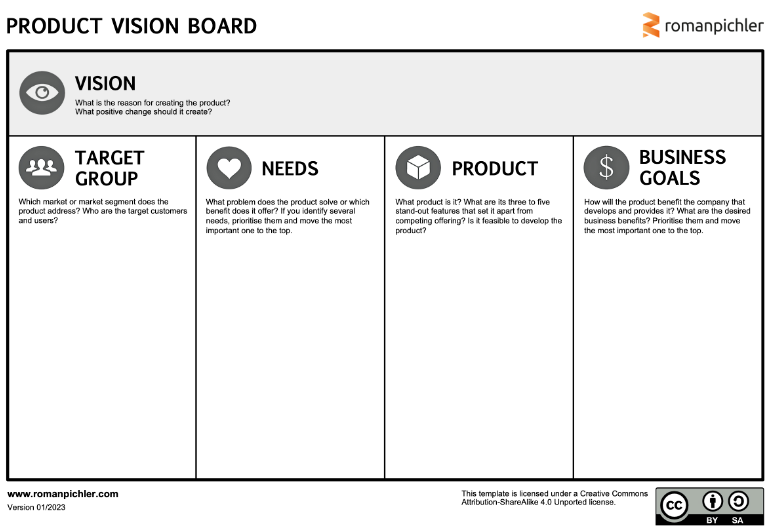Product Envisioning: Agile Envision Phase and Team Ideation
By Team Lean Agile Intelligence

Agile Envision Phase and Team Ideation
Product envisioning is a crucial part of any product's success, and effective communication is one of the keys to achieving it!
This post delves into the most efficient methods to tackle Product Envisioning and reveals vital best practices that can be adopted during various phases of your learning journey. By adhering to these fundamental techniques, you can develop the competence and awareness necessary to execute effective team strategies. Nonetheless, it's crucial to recognize that Product Envisioning is only a fragment of the broader context. To attain a comprehensive insight into your team's present process status, we suggest using our free agile assessment for Product Team Agility or for DevOps Team Agility.
Product Envisioning and The Criteria Method
At Lean Agile Intelligence, we recognize Product Envisioning as a critical value that assesses the ability to envision success and effectively communicate it. We use four primary measurement criteria to assess your ability to promote team accountability and identify areas for improvement. In the following sections, we will discuss each criterion in detail and provide practical tips and techniques to help you strengthen your skills in this area.

Source - 8 Tips For Creating a Compelling Product Vision
Developing
Teams that are “developing” an understanding of the value of Product Envisioning and Ideation and adopting the foundational techniques should focus on the following improvements
-
The What: One Product Vision exists explaining the desired end state for 2-5 years out
- The How: Extended from a vision are product goals. Common industry practice is to use Objective and Key results to drive execution towards a vision. You can read more about that here.
- The How: Extended from a vision are product goals. Common industry practice is to use Objective and Key results to drive execution towards a vision. You can read more about that here.
-
The What: The Product Vision gives the team a shared understanding of what they are trying to accomplish
-
The How: Product ownership starts with a vision for the future. Steve Jobs once said “If you are working on something exciting that you really care about, you don’t have to be pushed. The vision pulls you.” Therefore, it’s the responsibility of the product owner to ensure there is a compelling and inspiring vision teams are working to accomplish. In this post, Roman Pichler outlines 8 tips for creating a compelling product vision.
-
Two great tools for getting started to craft a vision with a team or product goals are by Roman Pichler. They can be found here and here.
-
Emerging
Teams that are “emerging” beyond the foundational techniques of Product Envisioning and Ideation and are embracing it as they become more proficient, should focus on the following improvements
-
The What: The Product Vision is short and concise
- The How: One way of achieving this is to focus on sprint goals. A sprint goal states the purpose of a sprint while acting as a shared objective for the team to achieve. Roman Pichler has a fantastic template which you can use to formulate sprint goals. You can utilize the entire template or whatever is appropriate for your context. It’s important to note that the goal is formulated throughout sprint planning and finalized by the end. It is not dictated from the beginning. It’s a good practice for Product Owners to have an idea of what the goal could be based on the prioritization and express that to the team at the beginning. This allows for the focus during the sprint to be about achieving the goal and not given set of output. For example, at the daily scrum, the team reviews progress towards the sprint goal, and then creates a plan for the next 24 hours to achieve it. The scope of the spring backlog can be adjusted as needed throughout the sprint to achieve the sprint goal.
- The How: One way of achieving this is to focus on sprint goals. A sprint goal states the purpose of a sprint while acting as a shared objective for the team to achieve. Roman Pichler has a fantastic template which you can use to formulate sprint goals. You can utilize the entire template or whatever is appropriate for your context. It’s important to note that the goal is formulated throughout sprint planning and finalized by the end. It is not dictated from the beginning. It’s a good practice for Product Owners to have an idea of what the goal could be based on the prioritization and express that to the team at the beginning. This allows for the focus during the sprint to be about achieving the goal and not given set of output. For example, at the daily scrum, the team reviews progress towards the sprint goal, and then creates a plan for the next 24 hours to achieve it. The scope of the spring backlog can be adjusted as needed throughout the sprint to achieve the sprint goal.
-
The What: The Product Vision is inspiring, compelling, and empowering and focuses on the customer
-
The How: A large part of a product owner's responsibilities is stakeholder and customer engagement and expectations management. Communication skills are paramount to becoming a great product owner. Henrik Kniberg has a fantastic video where he discusses this topic in depth. That video can be found here.
-
A quote from that video covers this topic - “Product Ownership is really all about communication. When I ask experienced product owners what it takes to succeed, they usually emphasize passion and communication. It is no coincidence that the first principle of the agile manifesto is “Individuals and Interactions over Processes and Tools. So the PO’s job is not to spoon-feed the team with stories. That’s boring and ineffective. The PO, instead, makes sure everybody understands the vision, that the team is in direct contact with stakeholders, and that there is a short feedback loop in terms of frequent deliveries to real users. That way the team learns and can make daily tradeoff decisions on their own, so the PO can focus on the big picture.”
-
-
The How: “Design thinking is a human-centered approach to innovation that draws from the designer’s toolkit to integrate the needs of people, the possibilities of technology, and the requirements for business success.” - Taken from this blog post defining design thinking at IDEO.
-
One technique of design thinking is empathy mapping. Here is a blog post that details a template for empathy mapping that’s updated regularly.
-
-
* * * * * *
"It’s not enough to create OKRs but for them to be valuable, everyone involved in executing the OKRs needs to understand and how their daily work aligns to OKRs."
* * * * * *
Adapting
Teams that are “adapting” the Product Envisioning and Ideation practice to extract the full benefit, should focus on the following improvements
-
The What: There is a clear connection point between the Product Vision and higher-level business strategy and objectives
- The How: It’s not enough to create OKRs but for them to be valuable, everyone involved in executing the OKRs needs to understand and how their daily work aligns to OKRs. One tip for accomplishing this is to tie success criteria of features and stories back up to the OKRs and regularly review OKR performance with everyone involved.
-
The How: One technique we recommend is called “Discovery Kanban” which pulls in design and research officially into an agile process. It contains two parts “Problem understanding” and “Solution Discovery.” In the Problem Understanding phase we gather data to help us understand and frame the problem. Data includes both qualitative and quantitative data, such as customer interviews, surveys, support tickets, sales call feedback, product usage, and NPS feedback. That data either becomes general company knowledge, such as our user personas, or feeds directly into the Solution Exploration phase.
In Solution Exploration, designers use the data gathered during Problem Understanding to frame the problem to be solved. Designers explicitly write down what the problem is, use cases, target users, and anything that’s out of scope. After getting buy-in from the PM and team, they explore solutions by creating sketches, wireframes, and prototypes. Engineers are looped in to provide feedback on technical feasibility. Researchers do usability testing in this phase as well. Finally, the output is finished designs that are fully thought through. This means there are no open questions about what a feature does that would slow down an engineer during development. More info can be found from the blog post by optimizely here.
- The How: It’s not enough to create OKRs but for them to be valuable, everyone involved in executing the OKRs needs to understand and how their daily work aligns to OKRs. One tip for accomplishing this is to tie success criteria of features and stories back up to the OKRs and regularly review OKR performance with everyone involved.

Optimizing
Teams “optimizing” the knowledge sharing of the Product Envisioning and Ideation practice learnings across the enterprise should focus on the following improvements
-
The What: Team members can recite the Product Vision
-
The How: By involving team members in defining the product vision, using visual aids, regularly communicating and reinforcing the vision, and providing training and education, Agile teams can ensure that team members can effectively recite the product vision and align their work towards the shared vision. Here are examples of ways teams can ensure that team members can recite the product vision:
-
Product Vision Workshops: Agile teams can conduct product vision workshops to collaboratively define and articulate the product vision. These workshops can involve team members from different roles, such as product owners, developers, designers, and other stakeholders, to collectively discuss, brainstorm, and craft the product vision. The team can use techniques such as brainstorming, story mapping, or visual modeling to create a shared understanding of the product vision and ensure that team members are actively involved in the process. This helps team members to internalize and understand the product vision, making it easier for them to recite and communicate it effectively.
-
Vision Statements: Agile teams can create concise and memorable vision statements that capture the essence of the product vision. Vision statements should be simple, clear, and inspirational and should convey the purpose, value, and direction of the product in a memorable way. For example, a vision statement for a project management software could be "Empowering teams to collaborate and deliver with ease," which conveys the purpose and value of the product in a succinct and memorable manner. Agile teams can use vision statements in team meetings, daily stand-ups, and other team interactions to reinforce the product vision and ensure that team members can recite it.
-
Visual Aids: Agile teams can use visual aids, such as posters, infographics, or visual models, to represent the product vision in a visual and tangible way. These visual aids can be displayed in team workspaces, meeting rooms, or other common areas to serve as constant reminders of the product vision. Visual aids can include key concepts, keywords, or diagrams that represent the product vision, making it easier for team members to recall and recite the vision. For example, a visual model such as a "Product Vision Canvas" or a "Product Vision Board" can help Agile teams capture and visualize the key elements of the product vision, making it easier for team members to remember and articulate it.
-
-
* * * * * *
"Try sharing your teams’ improvements and success at communities of practice and internal blog posts within your company so other teams can learn from your experience."
* * * * * *
Conclusion
In conclusion, a compelling and inspiring vision for your product is critical to success, and effective communication is the key to achieving it. By following the learning journey outlined in this post, you can promote team accountability and identify areas for improvement in your product envisioning efforts. Whether you're just starting or emerging in your understanding of product envisioning, there are practical tips and techniques that you can use to strengthen your skills and improve your product's success. If you are interested in the holistic view of your team’s current process status, you can take our free agile assessment for Product Team Agility or for DevOps Team Agility.